VR & Mixed-Realities Play Kit to Prepare Under 10s for an MRI Scan
January 2019-March 2021
Funded by Innovate UK
Dylan Yamada-Rice, (formally) RCA & Dubit (PI) and Co-Is Penny Curtis & Jill Thompson, University of Sheffield, Steve Love, Glasgow School of Art, Helen McQuillian, Sheffield Children’s Hospital NHS Trust
This was a collaborative research and development project to produce a mixed realities (physical, augmented and virtual reality) play kit to help prepare children to have an MRI scan without a general anaesthetic. Children were included throughout the research projects, as co-designers and testers of the play kit.
Play Kit Design
The final product includes three types of play to help children prepare for different elements of the MRI experience. These are (1) physical play to learn about an MRI scanner, (2) augmented reality play to learn about the job of a radiographer and (3) virtual reality play to explore the journey of having an MRI scan from entering the hospital to completion.
Physical Play: Learning about what an MRI scanner looks like
When a child recieves an appoint from the hospital for their MRI scan they are sent a playkit in the post. Part of this is a cardboard kit that can be turned into a toy MRI scanner. For young children, who do not have access to their own smart phone, physical play can be used to promote repeat play and thus familiarisation with the MRI process.
Our research showed that once children had built the cardboard MRI scanner, they personalised it with stickers and drawings. For some children it was combined with other toys they owned, i.e., turning a dollhouse into a hospital to house the scanner.
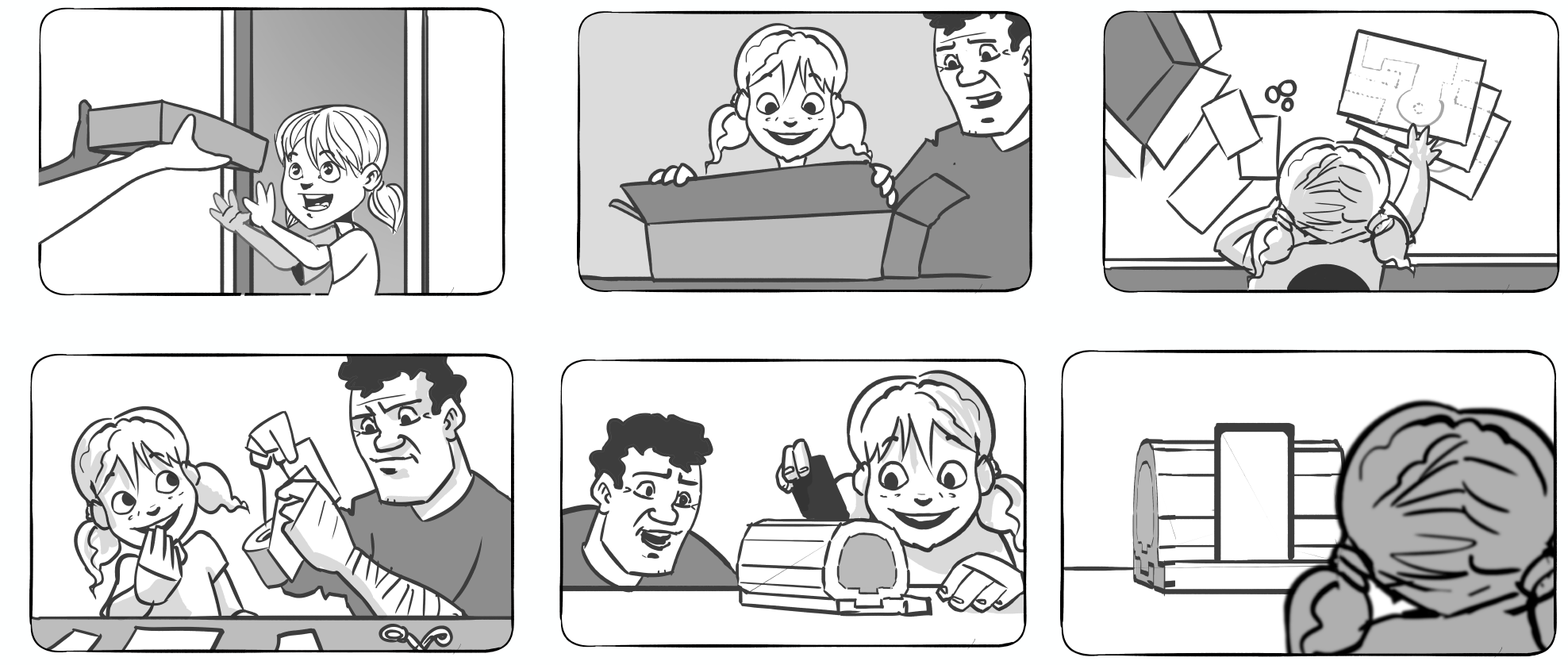
Video: Look & Feel for the cardboard MRI scanner kit instructions
Once built, the cardboard MRI scanner can be combined with a smart phone. This allows the child to access augmented play mode. In this mode they can give their favourite small toy an MRI scan. In doing so the child can explore the role of the radiographer. By becoming familiar with the processes undertaken by the radiographer they can gain confidence ahead of having their own scan. After playing with this part of the kit, children in our research said that while they were having their own MRI scan, they were able to imagine the radiographers looking at the inside of their bodies and were not worried about what was happening.
Video: playing in augumented reality mode to learn about a radiographer’s job
The initial research we conducted with children as part of a pre-design phase indicated that it was important to them that the app included scans that looked real, rather than anything cartoony or drawn for a child audience:
The initial research we conducted with children as part of a pre-design phase indicated that it was important to them that the app included scans that looked real, rather than anything cartoony or drawn for a child audience:
Virtual Reality: Exploring the MRI process
The play kit sent to children also contains a simple to use cardboard VR Headset. Children are given the option to select virtual reality play on the smart phone app and then insert it into the headset:
The VR part of the play kit takes children on the journey from the hospital reception to entering the MRI scanner:
Video: Interactive game for children to practice staying still, which is a skill needed to complete a successful MRI scan
Research & Development
The project was split into 5 phases.
Phase 1: Preconception Research
This consisted of a series of in-school workshops to understand children’s attitudes to having an MRI, as well as their favoured types of play. The child-participants also trialled existing apps for helping children prepare for an MRI, as well as played games to share ideas they had for staying still, which is one of the core skills children need to successfully complete and MRI scan. In addition this stage also collected data about parental concerns and attitudes via a questionnaire.


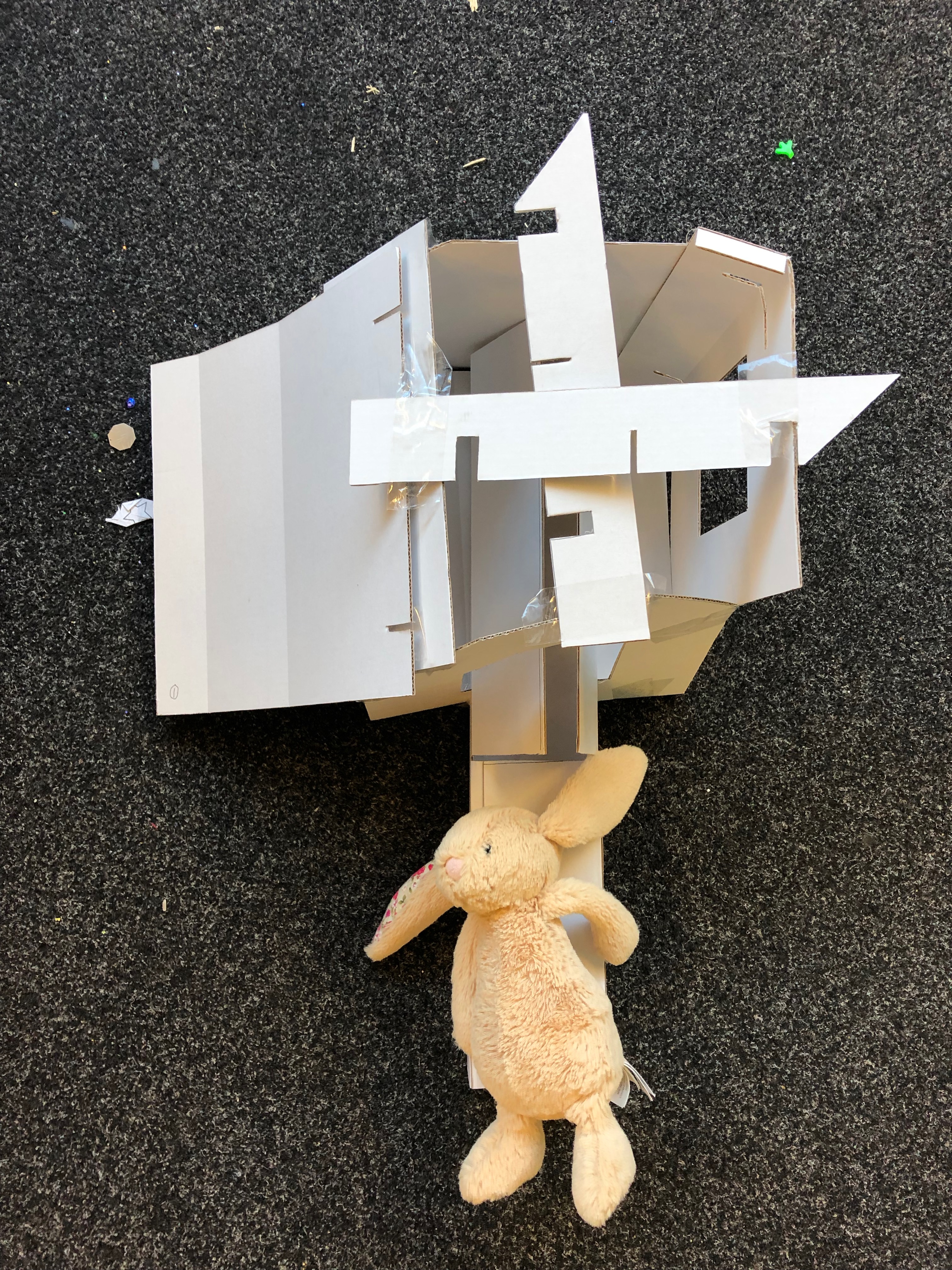
Phase 2 Initial Development
Development of the play kit was on three separate but interconnected elements that use different platforms for play (1) physical, (2) Augmented Reality and (3) Virtual Reality. The image directly below shows how I initally conceptualised information, in this case details of having an MRI scan, as relating to different play platforms. This is because each platform uses a different combination of communication modes (i.e. moving image, still image, sound, movement, audio etc) making some parts of the information visible and others more hidden. In addition to this because of the young age of the intended users for the play kit, it was likely that they would not continuously have access to digital tech needed to use some aspects of the kit and we wanted to promote repeat play in order that children could become familiar with the MRI scan process.

At each stage of the development a series of iterative prototypes were produed:
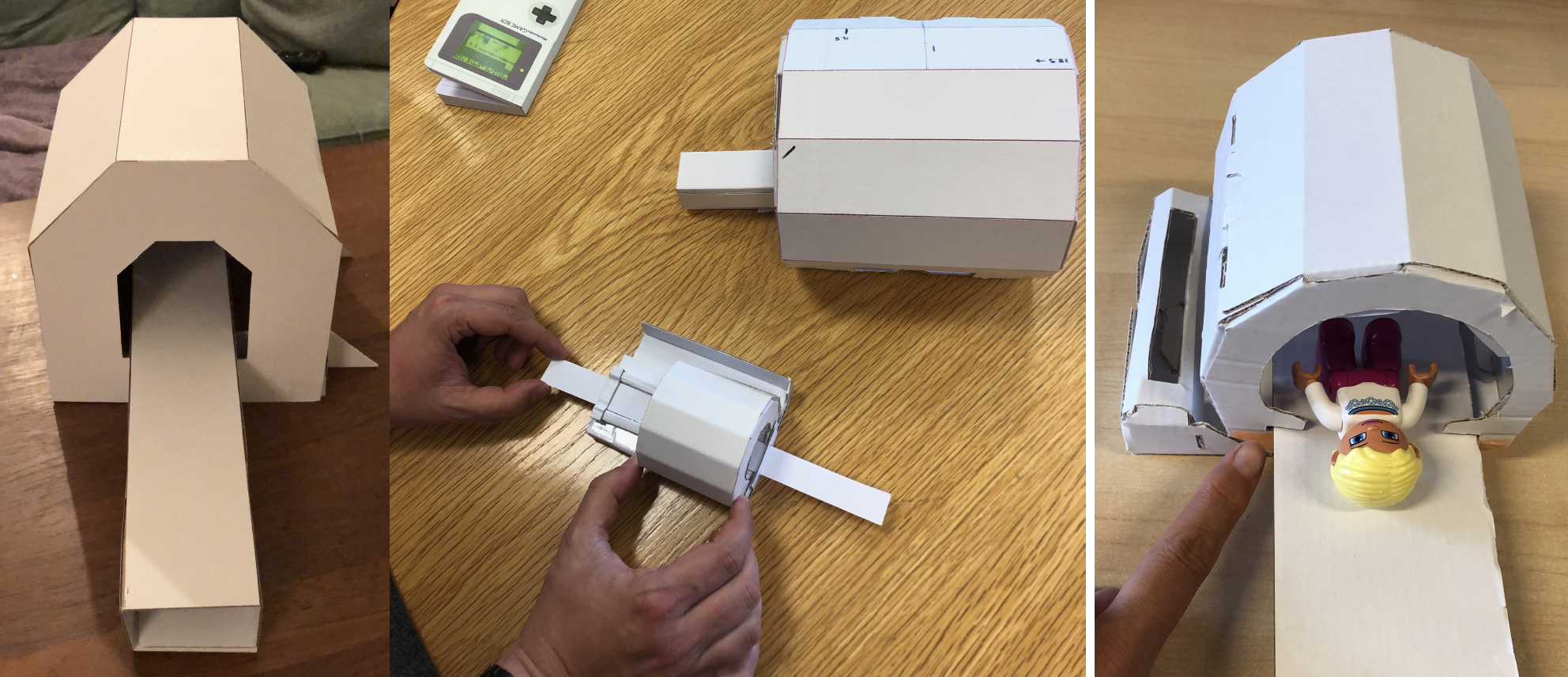 Images: iterative designs for the MRI cardboad scanner, testing shape and size
Images: iterative designs for the MRI cardboad scanner, testing shape and size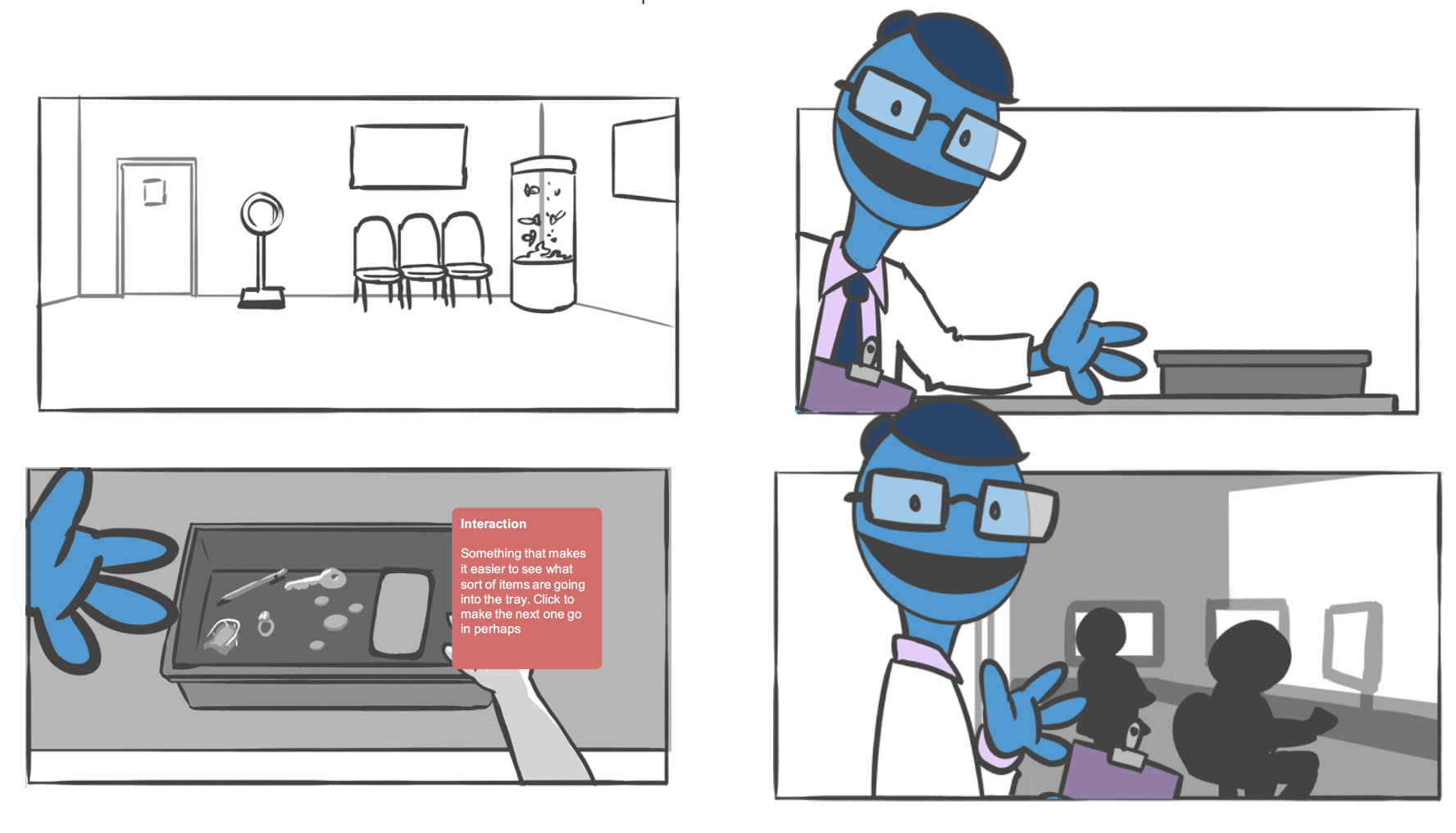 Images: Storyboarding the narrative and interactive elements
Images: Storyboarding the narrative and interactive elementsThis also happened directly with children in the form of charater design research:
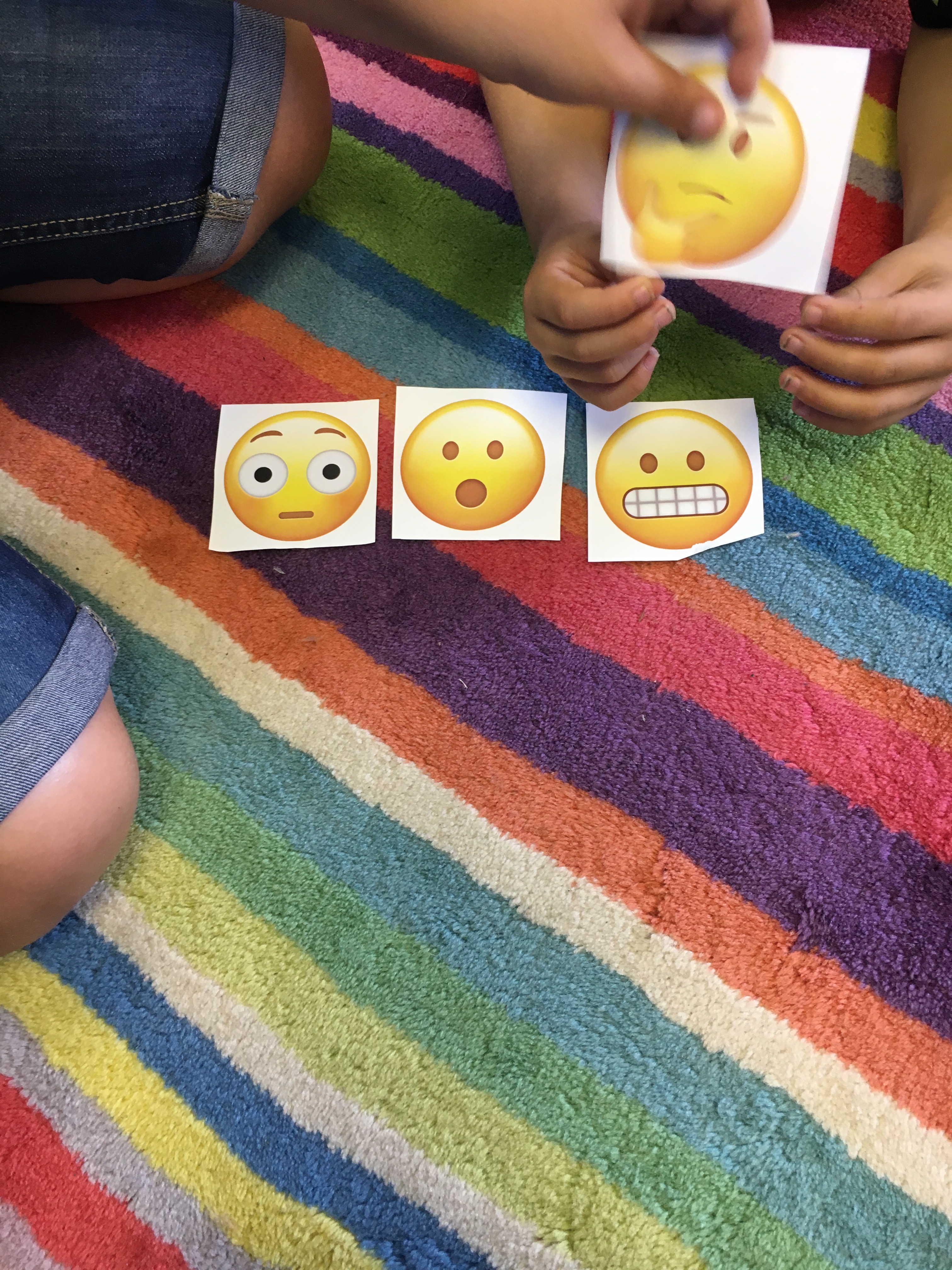
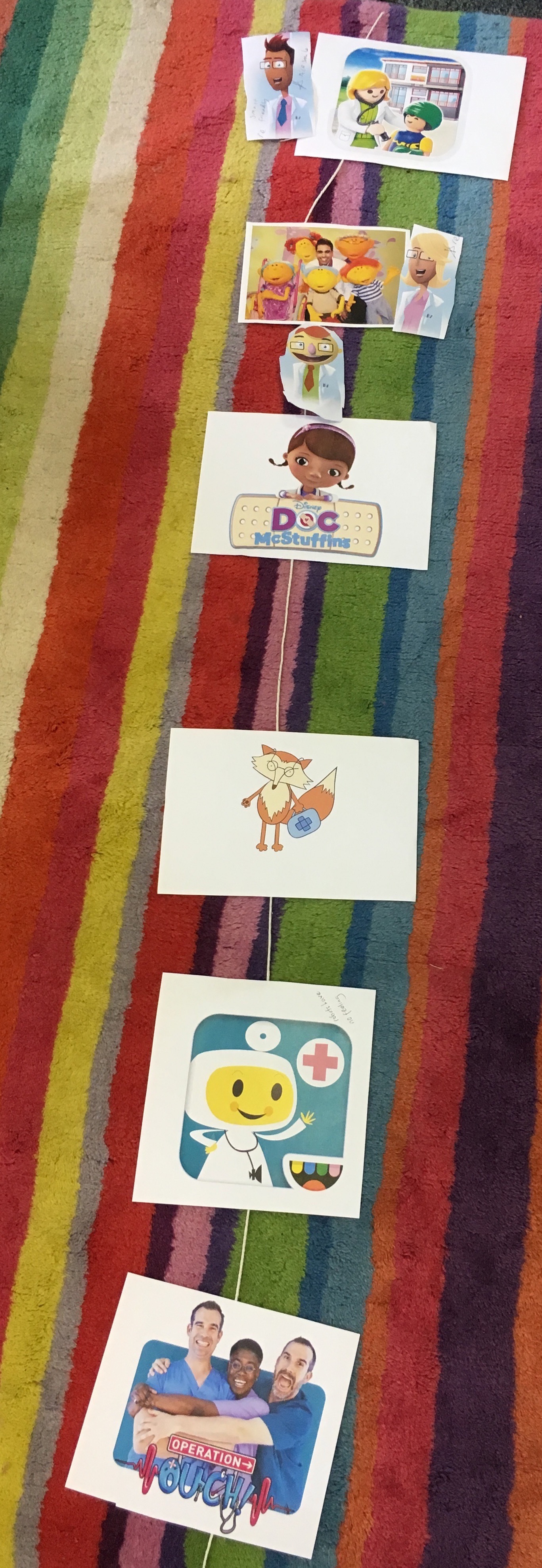
Image: Character design workshop
Phase 3: User Testing
At the end of the initial development phase we tested the developing playkit with children, by sending copies of the kit to their home. We observed their initial reactions to unboxing the play kit and using it. Parents of child-participants also kept a research diary to record how children used it over a one-week period. We wanted to know if children would play with it more than once. From this phase we learnt several things, including that children wanted to practice staying still while lying down, as if in an MRI scanner:
Phase 3: User Testing
At the end of the initial development phase we tested the developing playkit with children, by sending copies of the kit to their home. We observed their initial reactions to unboxing the play kit and using it. Parents of child-participants also kept a research diary to record how children used it over a one-week period. We wanted to know if children would play with it more than once. From this phase we learnt several things, including that children wanted to practice staying still while lying down, as if in an MRI scanner:

Image: Child used the VR app to practice staying still
Also children enjoyed decorating the cardboard kit with stickers and drawings and also played with it in combination with other toys they owned.
Phase 4: Further Development & Tuning
This was another development stage, primarily for the VR part of the play kit. During this stage three MA Information Experience Design students at the Royal College of Art joined to focus on sound (Dimitrios Menexopoulos), instructions (Kyungjin Jeong) and packaging design (Akvile Terminites).
The MRI scanner sound design was produced by Dimitrios Menexopoulos who responded to Stage 1 research findings that showed children were both intrigued by the sound of the MRI, i.e. where does the sound come from, how is it different for varied scans etc, as well as, the need to allow them to adjust to the volume of the noise and feel comfortable with it.He aimed to show that some sounds can be very loud and strange but not scary. In the second phase Dimitri made a recording of the MRI scanner from a visit to a hospital, then replicated this. In the replicated version the timing of the sound was slowed in order to match the scanning pace used in the AR app.
Phase 5: Full Playkit Testing with Children having and MRI Scan
The final workpackage involved testing the play kit with children schduled to undergo an MRI scan and meeting them afterwards to see if they felt the play kit had helped them. The findings showed not only had the play kit helped children prepare for the scan but that children thought of aspects of the kit while having a scan to enable them to remain calm and complete the process. For example, imaginging butterflies landing on a plant, which was the theme of the VR interactive game we had created to help children practice staying still. Children also mentioned that it knowing what an MRI scan looks like, which they had seen in the AR part of the play kit, also allowed them to imagine what the radiographers were looking at when they were being scanned, and thus offered another way for them to remain calm and complete the scan.
The MRI play kit was filmed for Series 11 of the CBBC show Operation Ouch and was braod cast as part of episode 10.
![]()
![]() Images: Operation Ouch filming, Spring 2022
Images: Operation Ouch filming, Spring 2022
![]()
![]()
![]()
![]() Images: Stills from Operation Ouch Series 11, Episode 10, Broadcast Spring 2022
Images: Stills from Operation Ouch Series 11, Episode 10, Broadcast Spring 2022
Pope, C. (2023) Playkit May Aid Children in Preparing for MRI. Pubplished on drugs.com (8/11/23)Link![]()
VR/AR Playkit Eases Child, Parent Anxiety Pre-MRI Scan, Mirage news (10/11/23). Link.
Reducing kids’ MRI anxiety with papercraft and VR, Healthcare-in-Europe.com (08/11/23). Link.
![]()
Astbury-Ward, E. (2023) Playkits develop role in easing kids’s anxiety over MRI scans, Aunt Minnie.com (08/11/23). Link.
![]()
Virtual/augmented reality playkit eases kids’ and parents anxieties ahead of MRI scan. Eurek Alert. (07/11/23). Link.
![]()
Virtual/augmented reality playkit eases kids’ and parents anxieties. Scien Mag (08/11/13)
Virtual/augmented reality play set eases kids’ and parents’ anxieties ahead of MRI scan. Medical Press (07/11/23). Link.
![]()
![]()
Revolutionising Pediatric Healthcare: Augmented And Virtual Reality Playkit Eases MRI Anxiety In Children. AR Rock. Link
![]()
Meredith, S. (2023) Virtual Reality Play Kit May Ease MRI Anxieties for Children. Medscape UK. (10/11/23). Link.
![]()
Playkit May Aid Children in Preparing for MRI. Modern Clinician.
![]()
Also children enjoyed decorating the cardboard kit with stickers and drawings and also played with it in combination with other toys they owned.
Phase 4: Further Development & Tuning
This was another development stage, primarily for the VR part of the play kit. During this stage three MA Information Experience Design students at the Royal College of Art joined to focus on sound (Dimitrios Menexopoulos), instructions (Kyungjin Jeong) and packaging design (Akvile Terminites).
The MRI scanner sound design was produced by Dimitrios Menexopoulos who responded to Stage 1 research findings that showed children were both intrigued by the sound of the MRI, i.e. where does the sound come from, how is it different for varied scans etc, as well as, the need to allow them to adjust to the volume of the noise and feel comfortable with it.He aimed to show that some sounds can be very loud and strange but not scary. In the second phase Dimitri made a recording of the MRI scanner from a visit to a hospital, then replicated this. In the replicated version the timing of the sound was slowed in order to match the scanning pace used in the AR app.
Phase 5: Full Playkit Testing with Children having and MRI Scan
The final workpackage involved testing the play kit with children schduled to undergo an MRI scan and meeting them afterwards to see if they felt the play kit had helped them. The findings showed not only had the play kit helped children prepare for the scan but that children thought of aspects of the kit while having a scan to enable them to remain calm and complete the process. For example, imaginging butterflies landing on a plant, which was the theme of the VR interactive game we had created to help children practice staying still. Children also mentioned that it knowing what an MRI scan looks like, which they had seen in the AR part of the play kit, also allowed them to imagine what the radiographers were looking at when they were being scanned, and thus offered another way for them to remain calm and complete the scan.
Impact
The MRI play kit was filmed for Series 11 of the CBBC show Operation Ouch and was braod cast as part of episode 10.
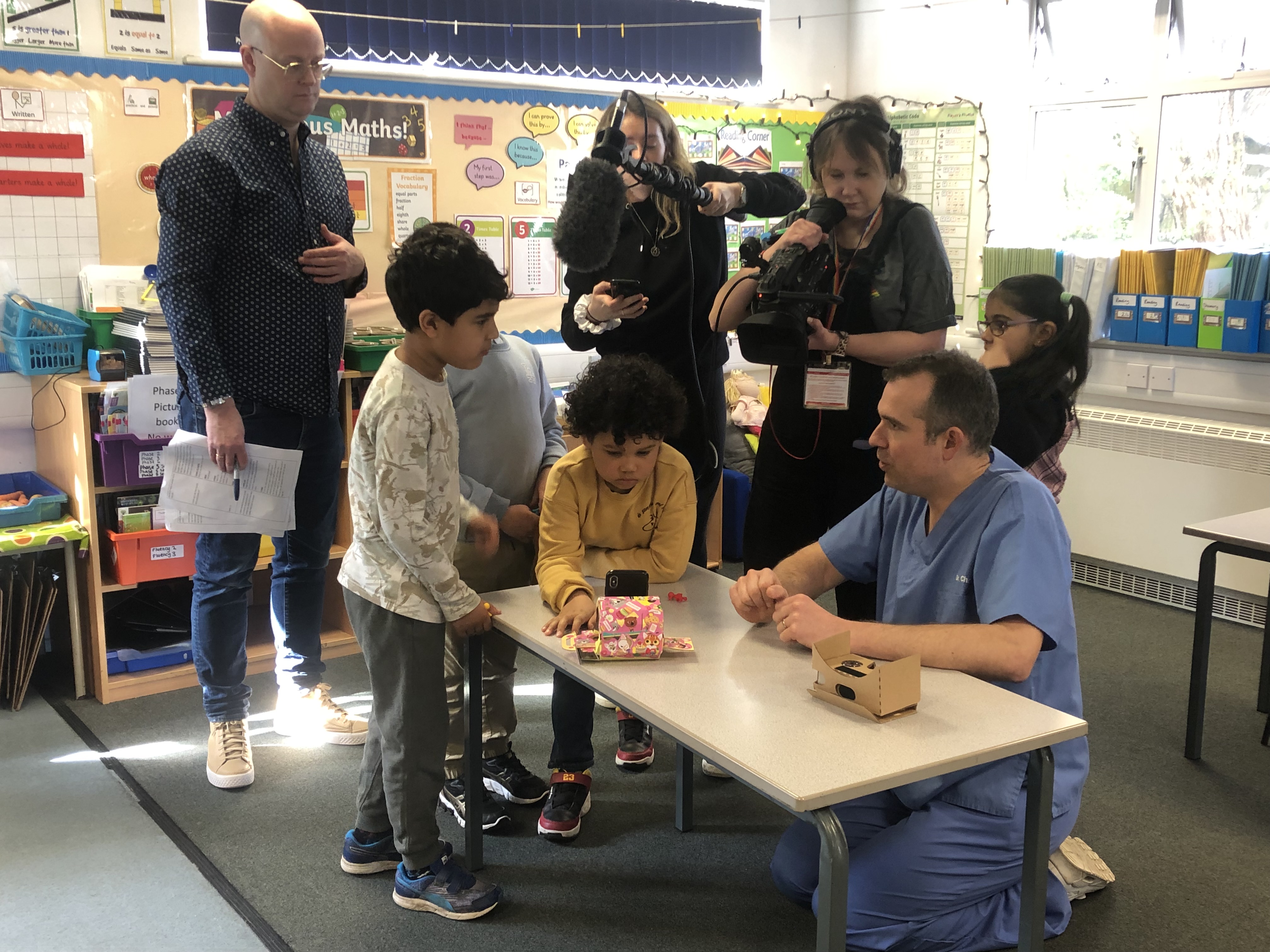
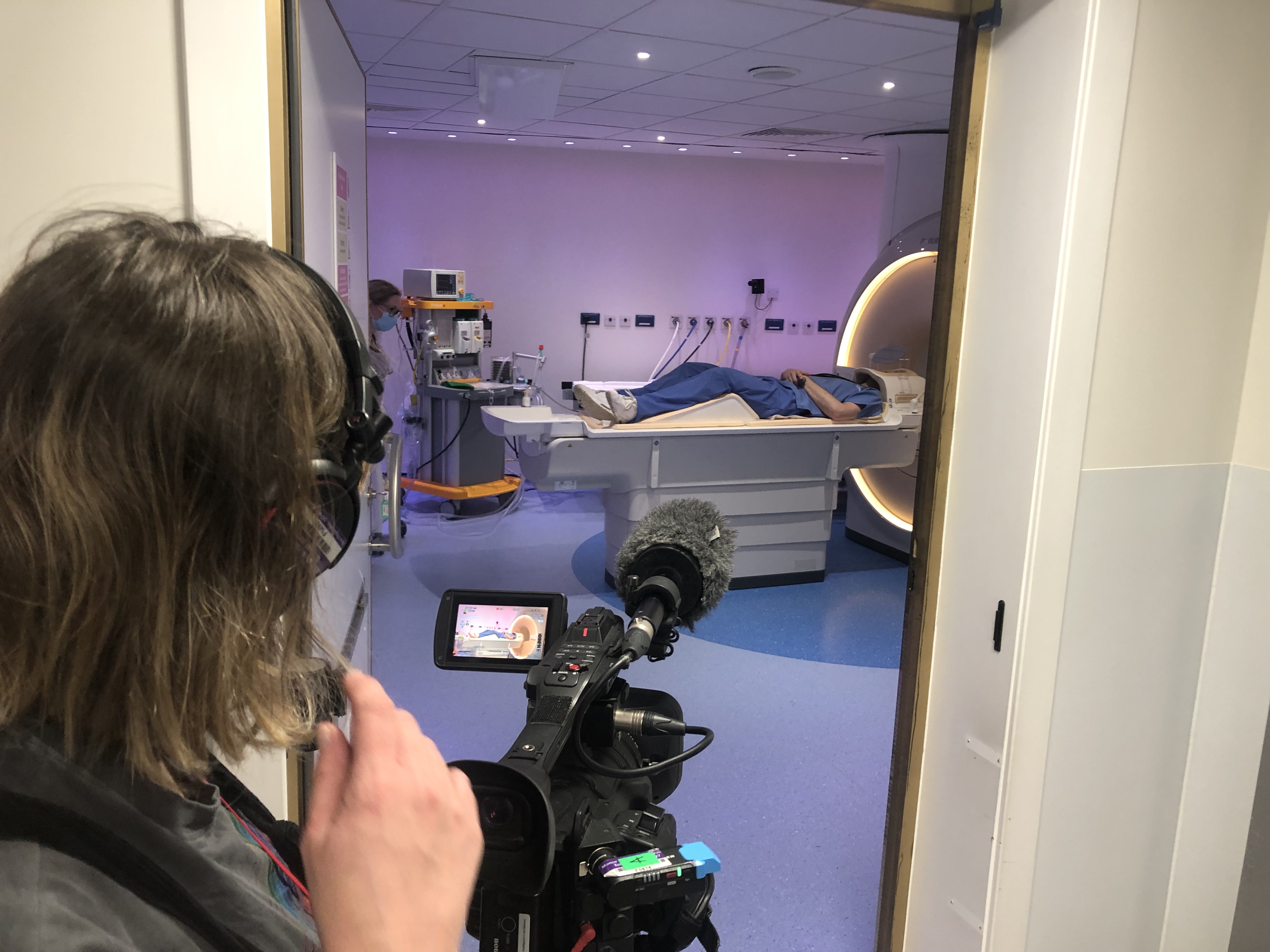
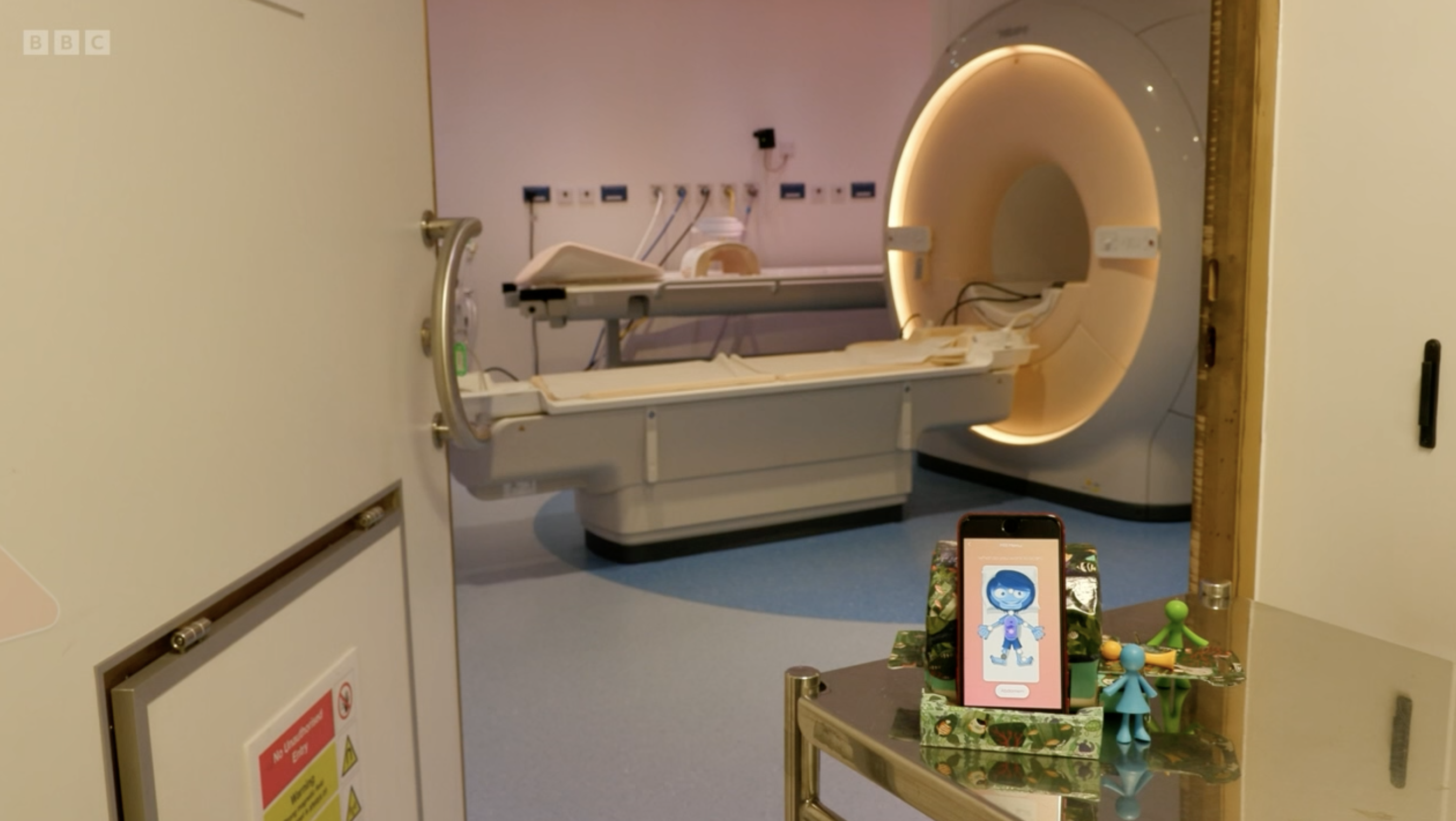


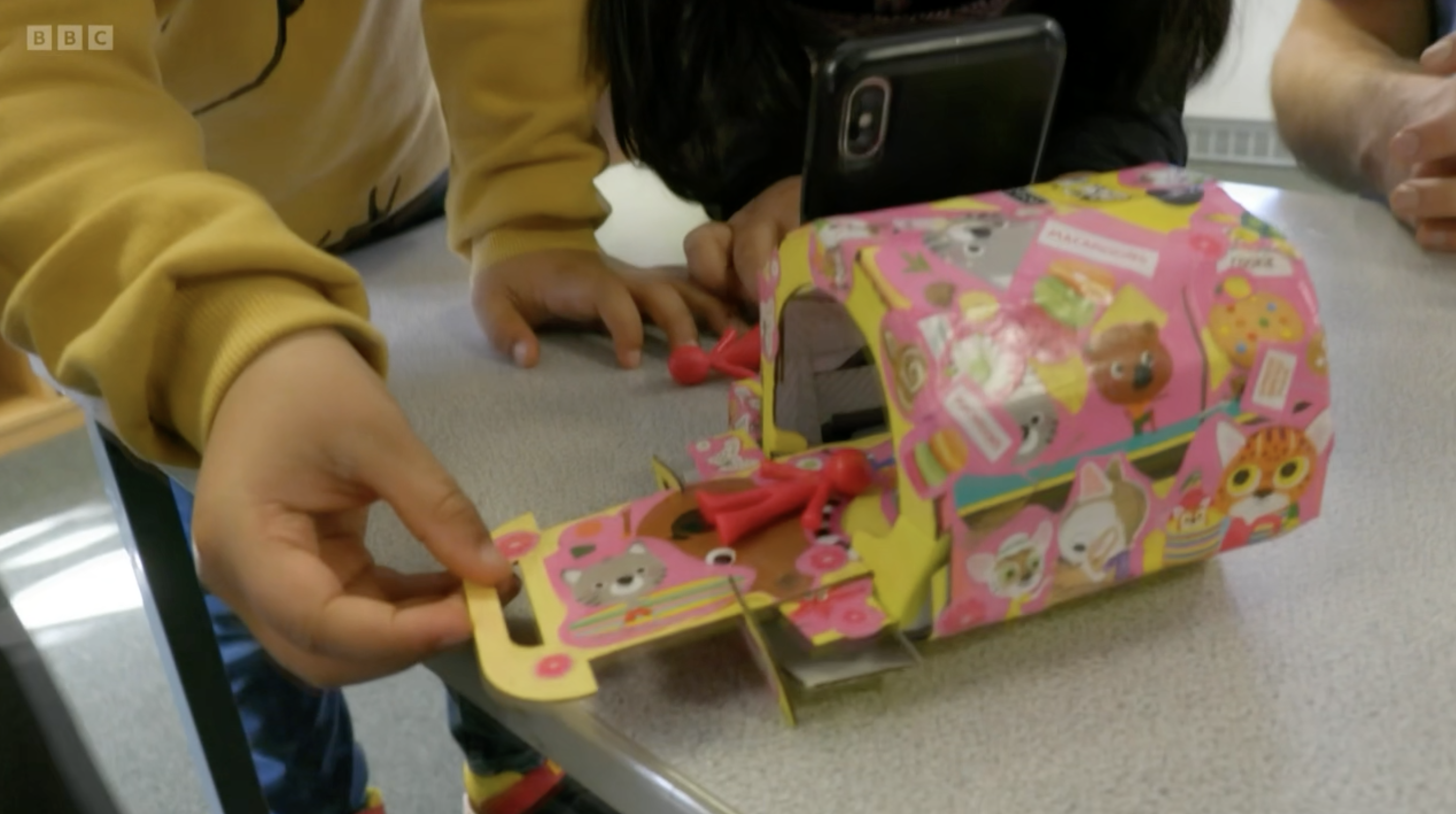
Press
Pope, C. (2023) Playkit May Aid Children in Preparing for MRI. Pubplished on drugs.com (8/11/23)Link
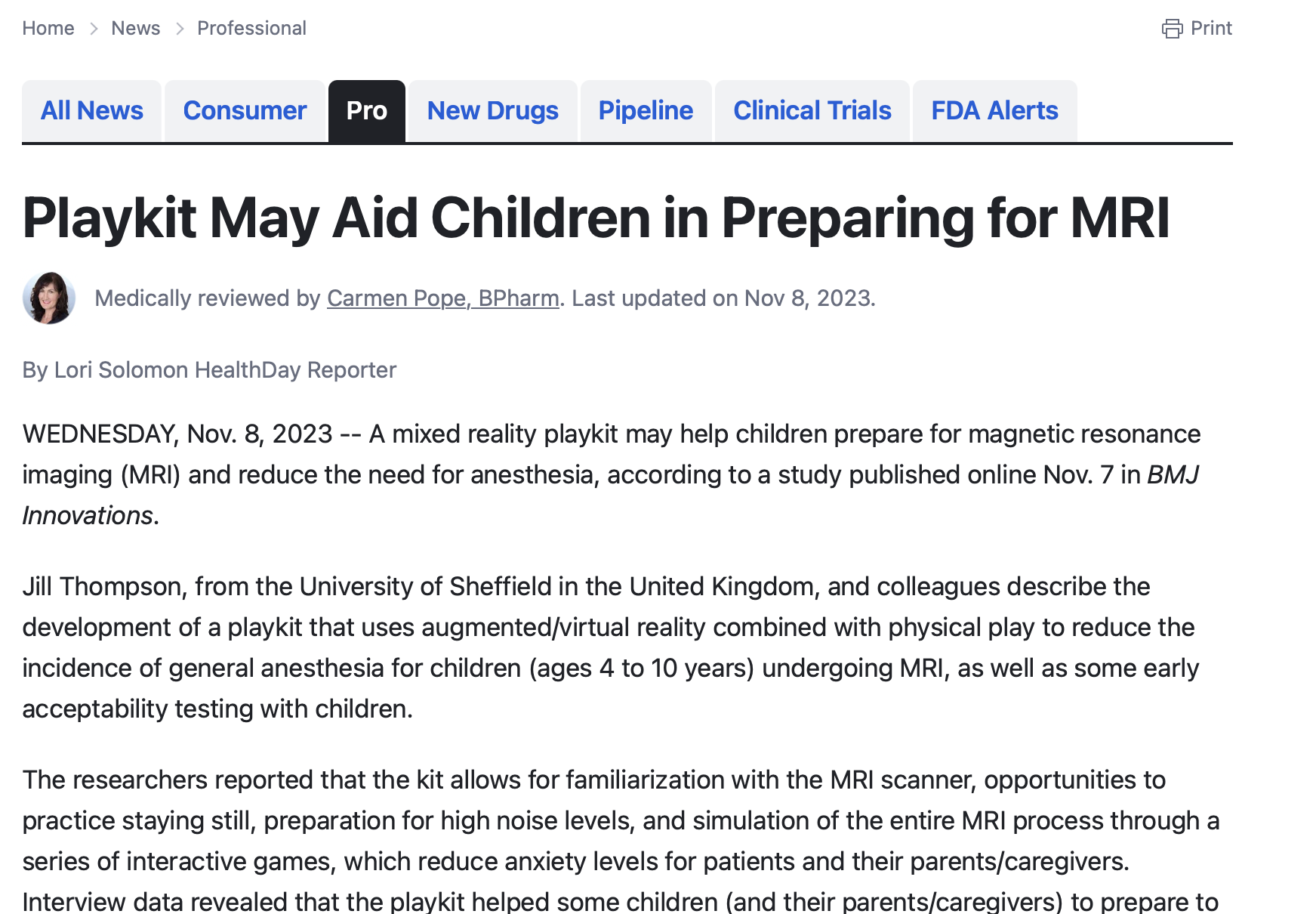
VR/AR Playkit Eases Child, Parent Anxiety Pre-MRI Scan, Mirage news (10/11/23). Link.
Reducing kids’ MRI anxiety with papercraft and VR, Healthcare-in-Europe.com (08/11/23). Link.

Astbury-Ward, E. (2023) Playkits develop role in easing kids’s anxiety over MRI scans, Aunt Minnie.com (08/11/23). Link.

Virtual/augmented reality playkit eases kids’ and parents anxieties ahead of MRI scan. Eurek Alert. (07/11/23). Link.

Virtual/augmented reality playkit eases kids’ and parents anxieties. Scien Mag (08/11/13)
Virtual/augmented reality play set eases kids’ and parents’ anxieties ahead of MRI scan. Medical Press (07/11/23). Link.

Virtual/Augmented Reality Play Kit Eases Kids’ and Parents’ Anxieties Ahead of MRI Scan. Psychreg News (07/11/23). Link.

Revolutionising Pediatric Healthcare: Augmented And Virtual Reality Playkit Eases MRI Anxiety In Children. AR Rock. Link

Meredith, S. (2023) Virtual Reality Play Kit May Ease MRI Anxieties for Children. Medscape UK. (10/11/23). Link.
AR pomaže djeci da prebrode MRI. Bug Hr. Link.
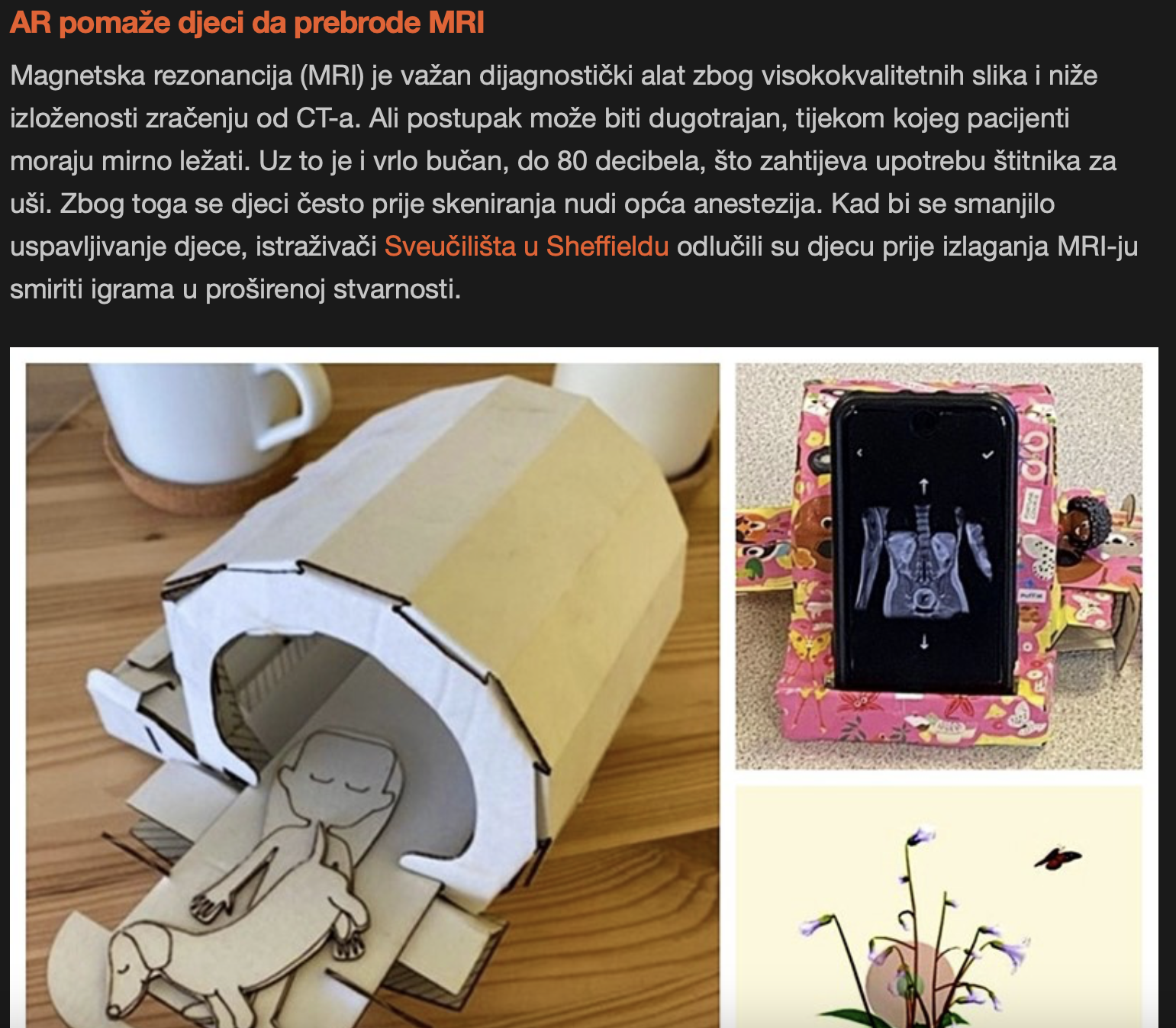
Playkit May Aid Children in Preparing for MRI. Modern Clinician.

Related Publications
Yamada-Rice, D., Thompson, J., Love, S., Thompson, S. & McQuillian, H. (2022) Mixed Realities Playkit to Prepare Children for an MRI Scan: Findings for health, families and Industry. Available online at: http://dubit.us/MRI
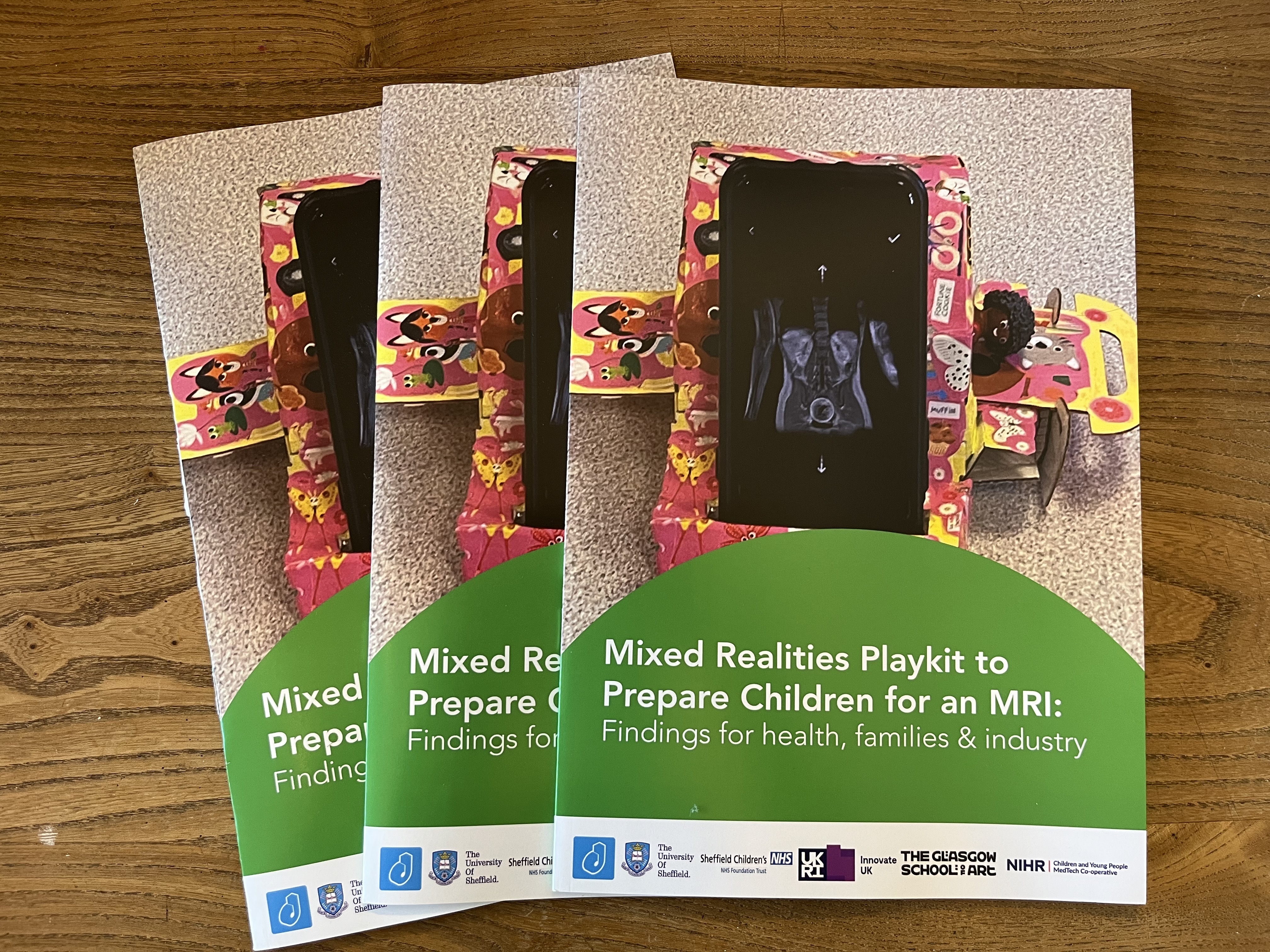
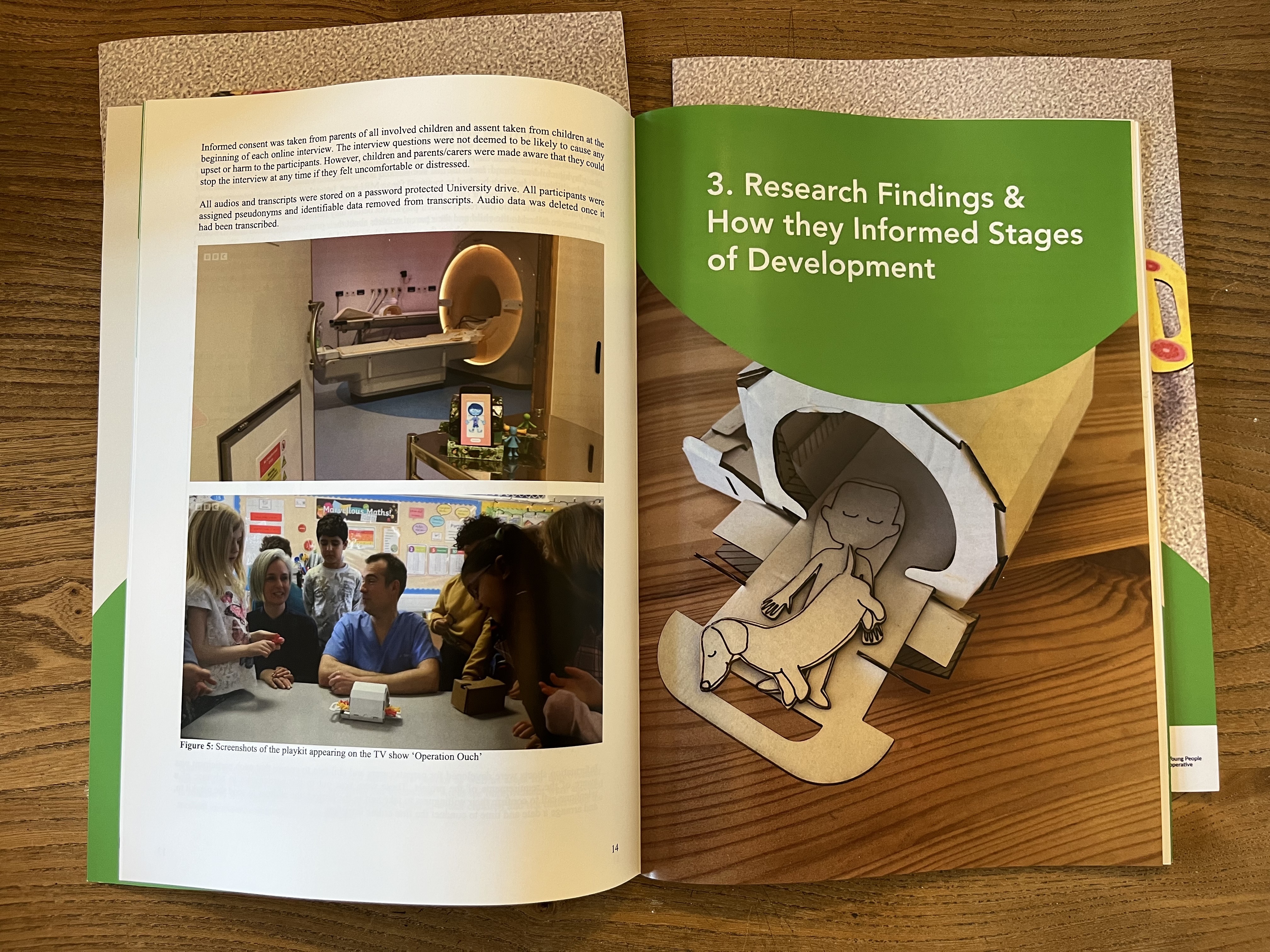
Yamada-Rice, D. & Love, S., (2019) Designing tech for health: Developing a mixed reality playkit to help children who need an MRI Scan RIAS Quarterly, 38 (38). p 57.
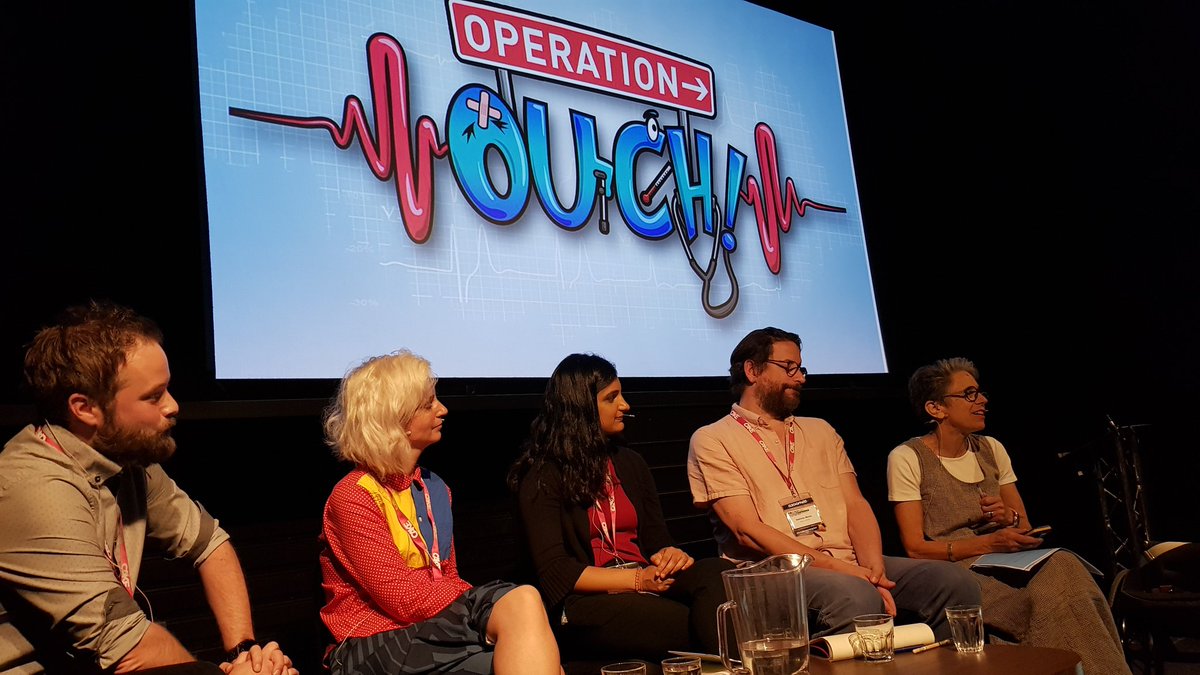
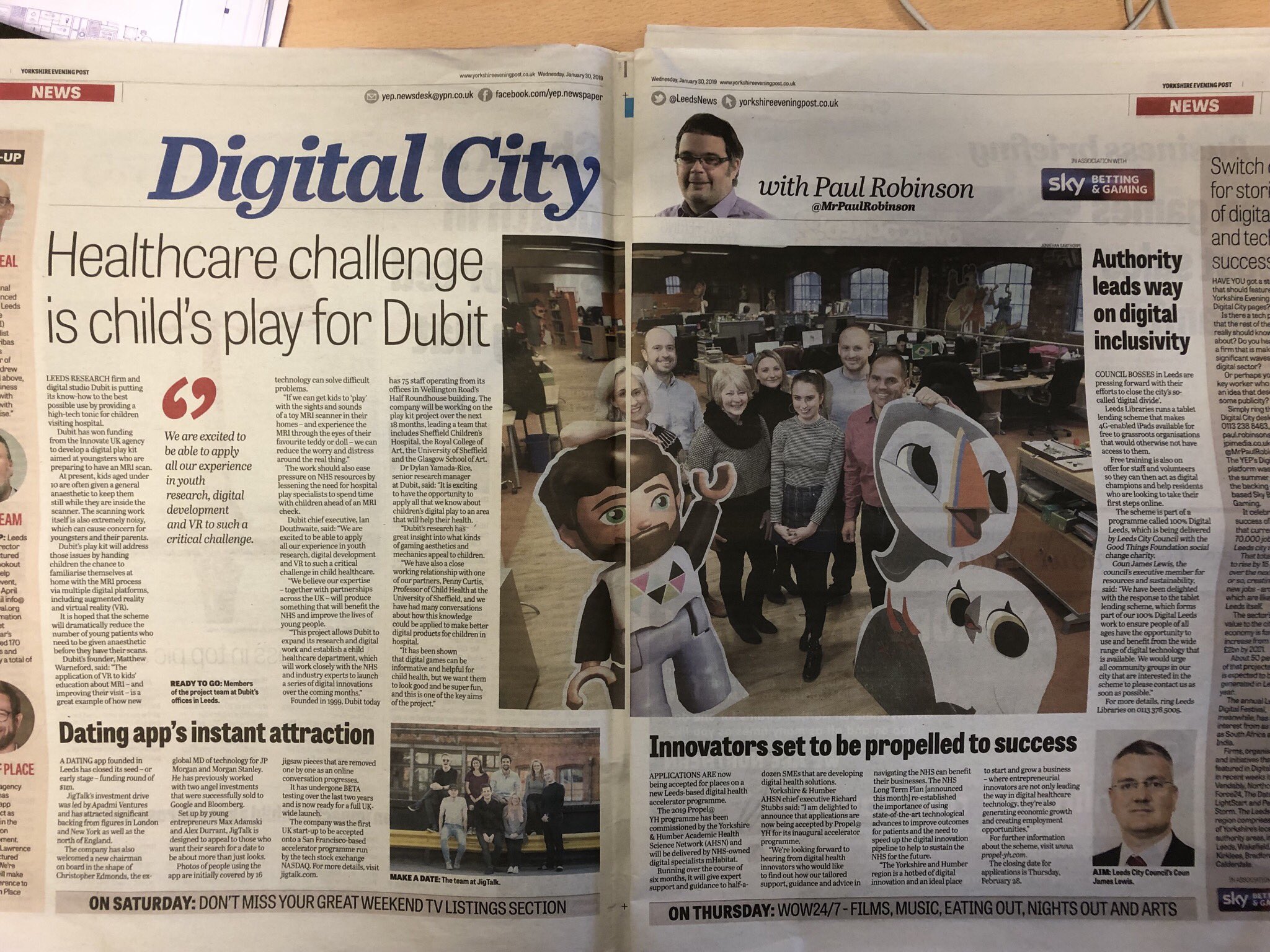
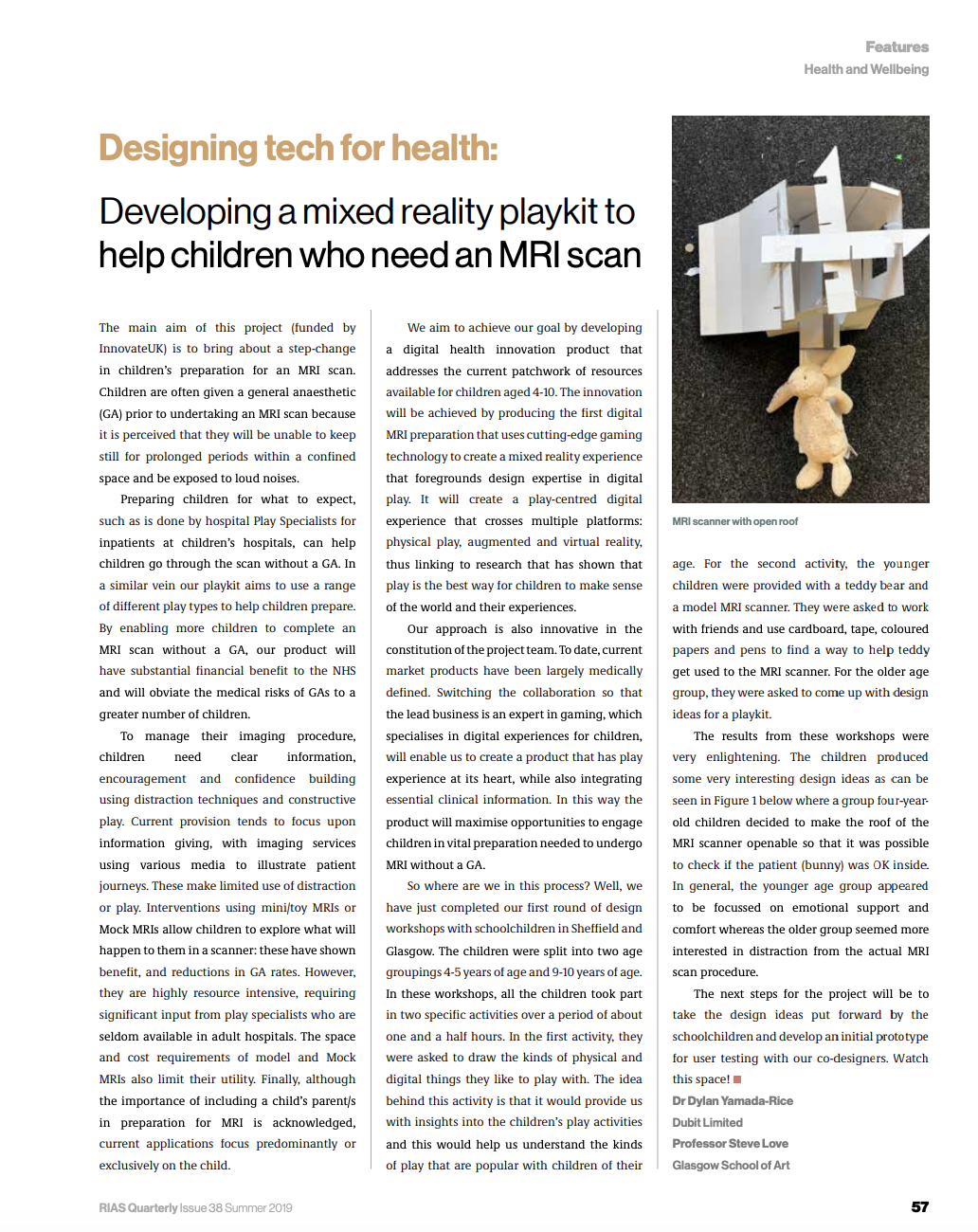
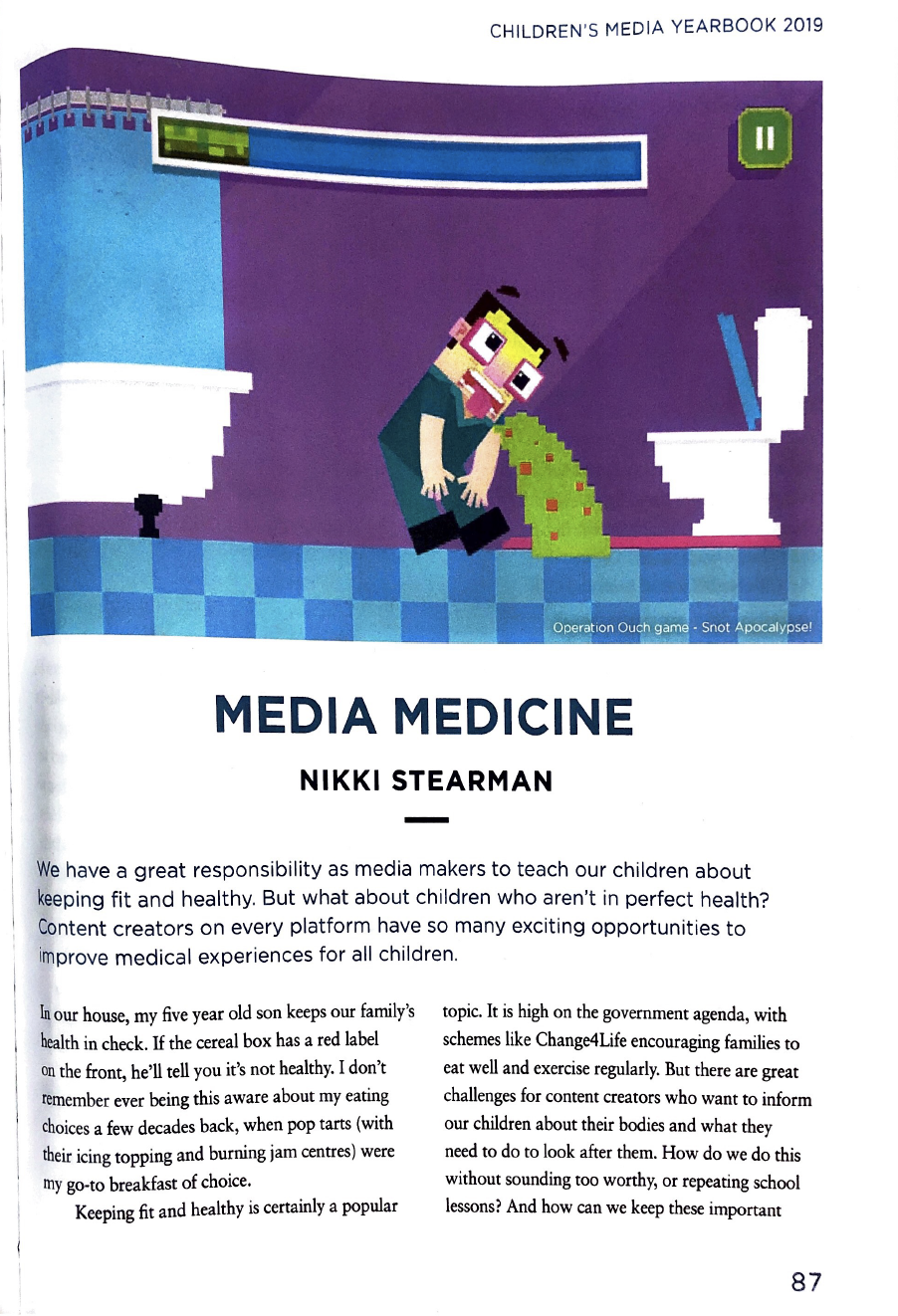
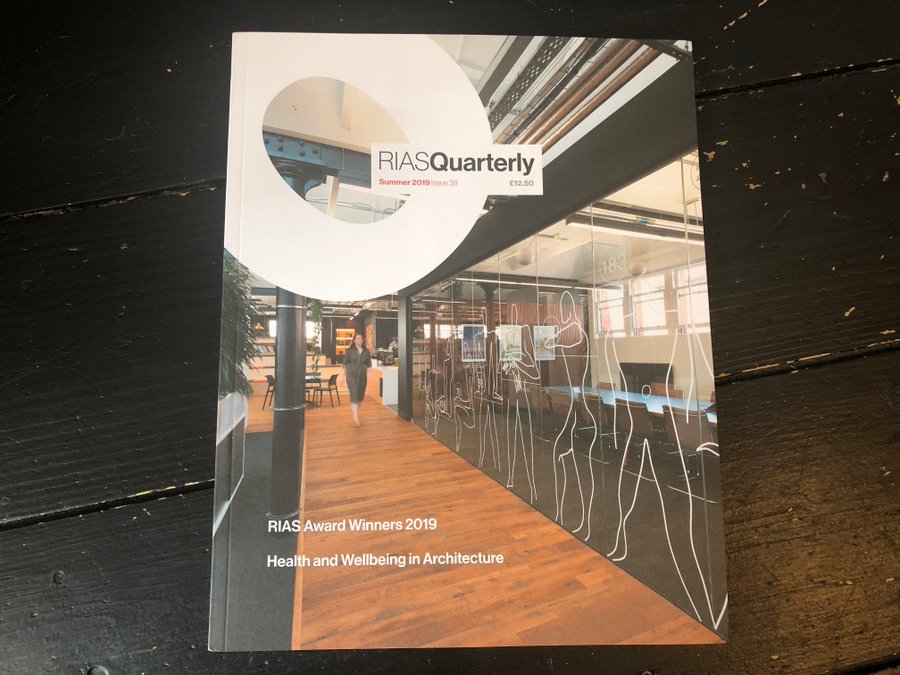
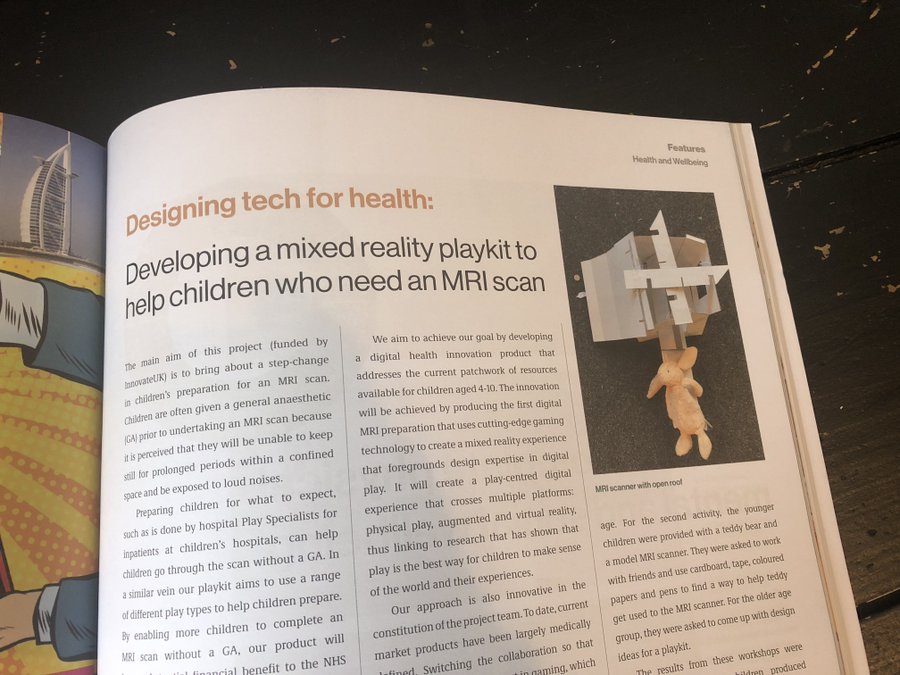
Images: Project dissemination
Related Talks
Yamada-Rice, D. (2021) Children Health Technology Conference (postponed from 2020)
Yamada-Rice, D. (2021) Kids Designing Tech for Health, Royal College of Paediatrics and Child Health Conference (Postponed from 28-30 April 2020 to 2021)
Yamada-Rice, D. (2019) Using Virtual Technologies for Child Health, Presentation for UT-Virtual students at Tokyo University, June 2019
Yamada-Rice, D. (2019) Digital Health Technology Showcase, Leeds Nexus
Yamada-Rice, D. (2019) Caring Together Conference, Sheffield Children’s Hospital NHS Trust.
Yamada-Rice, D. (2019) 10th Clash of Realities: International conference on Art, Technology and Theory of Digital Games, Nov 2019, Cologne, Germany